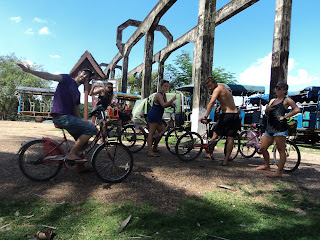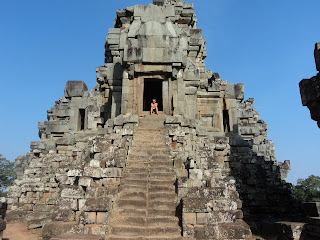
Vacationing through Vietnam certainly begs the question; could my children vacation to Iraq in 30 years time? I am sure my parents never imagined that I would be enjoying the chaotic buzz of Saigon, the white rolling sand dunes of Mue Ni, or the beautiful "Miamiesque" beaches of Nha Trang , all in Vietnam, a country that was the site of warfare and bloodshed just a few centuries ago, but I am. Vietnam is truly amazing, and the farthest thing from what I imagined. Every traveler has their opinion of certain countries or cities, and after receiving them, I discard them immediately. I have yet to find a place I haven't liked, and find that by keeping non-existent expectations I always end up pleased. Vietnam is no exception, but despite what people told me the jungled war-torn "Nam" of my youth was all I could envision, but it has been eye opening seeing the other side of the coin. Vietnam has a lot more infrastructure than Cambodia or Laos. As you drive through the patch worked countryside of fields and rice paddies, you see concrete houses, paved roads, and lamp posts. Vietnam borders the Pacific Ocean (the Vietnamese do not like it being called the South China Sea) which means stunning beach vistas at every turn. I thought some of the other Asian nations had a lot of motorbikes until I came to Vietnam where 60% of the population is said to drive motorbikes (but here at least people actually wear helmets.) While some travellers said the street sellers and people were unfriendly and persistently hostile, as long as I keep my spirits up with them, they have been nothing but pleasant (even knowing that I am American.) The only thing that hasn't been amazing, is the power outages. Due to lack of rain, Vietnam sells its electricity to Cambodia, so every other day entire cities lose power (which means cold dinners, hot sleeping conditions and dark nights) - ugh!
The first thing I did when I got to the Chaotic Ho Chi Min City was find Rego (my former travel buddy), who had been staying in the city for a couple of weeks watching the world cup, eating, drinking and sleeping (lots!) I peeled him out of bed and dragged him to some of the sites. First we headed to the Cu Chi tunnels, a 200km tunnel system outside of the city which housed the Viet Cong while they ran an effective ground operation during the war, where you can crawl through part of the tunnels (which have been widened for the westerners), shoot an AK-47 for 30,000 dong a bullet ($1 = 18,000 dong) and see the horrific jungle traps that were built and used on the American Soldiers.

The videos and commentary were clearly anti-American, and when I went to the War Remnants Museum later that day, I was not proud to be an American. I remember growing up hearing my mother speak of her neighbor and other friends who died in the Vietnam War, and even going to the Washington DC memorial to etch one of the soldier's names onto a piece of paper. What no one told me was that while we lost 50,000 people in the war, Vietnam lost 3 million (2 million of which were innocent civilians) not to mention the hundreds of thousands of people that live with the side effects of the chemicals, like Agent Orange, that we poured into their country. I realize there are two sides to every war, and like the protesters of the past, I do not want my children to look back on our current political situation with the same shame that I have to bear today. War is not the answer, then or now.
While in Ho Chi Min City, I also checked out the neo-Romanesque Notre Dame Cathedral and the Reunification Palace (built in 1966 to serve as the Presidential Palace, this was where the first Communist tanks crashed when the South surrendered to the North).

A day trip to the Mekong Delta, a series of islands that lie where the base of the Mekong River meets the Pacific Ocean, included a boat trip down one of the many rivers (with a funny cone hat on), watched (and tasted) coconut candy being made, played with a snake and drank honey bee tea while watching a traditional song and dance performance. After convincing Rego there will be other places in the country showing the World Cup, we headed north to Mui Ne.
Mui Ne is one long road parallel to the beach with lots of cute little restaurants, guesthouses, resorts and beachy shops.

The white sandy beach had lots of wind, so much that kite surfing schools have popped up all over the town, (there were about 50 surfers to every swimmer.) The only problem with Mui Ne was that there were no people there, and had I not been with Rego finding a friend would have proved difficult. On our second day in Mui Ne we rented motorbikes and cruised out to the "sahara of Vietnam", white and red sand dunes that oddly juxtapose the mountainous and beach landscape.

When we got there people charged us to park our bikes, charged us for plastic mats to sled down the mountain, and 3 little girls carried our sleds, showed us how to do it, offered to take our pictures, and then demanded 20,000 dong each at the end. The sweaty afternoon of sand sledding and bike riding and a hilarious night of attempting to get around in the flooded road after a severe rain storm, was well worth the stop in Mui Ne.
Our next stop was to the beach town of Nha Trang. A gridded city based along a beach as long as Miami's, but definitely not as clean or crowded. Some friends complained of late night robberies (although too drunk to put the scheme together, they all said money was taken out of their wallets), but overall I thought the city was nice enough. During our first day we headed to the beach and while I laid out in my bikini, the locals took swims in their shorts and shirts. That night we camped out at the local sports bar "why not?", and watched the USA world cup game.

There were 3 other Americans who helped support, but the majority of the crowd were bitter English, screaming "Go Guana" while expressing their other anti-American opinions. The following day a bunch of us headed to the Vinpearl waterpark (which included a ride in the longest over water cable car) and that night watched as the English were beat with the karma stick with their embarrassing 4-1 World Cup loss to Germany. Unfortunately Rego decided to stay in Nha Trang for another 2 weeks to watch the ENTIRE world cup (which I obviously didn't want to do), so we had to part ways again. We are hoping to see eachother again in Australia, or at my wedding day (I told him he could be one of the bridesmaids.)
I am currently in Hoi Ann, a quaint town set on the Thu Bon River. The "city" served as an international trading port as far back as the 17th century and is influenced by the Japanese, Chinese, and other European Cultures, which is apparent when walking through the narrow streets, which are lit up by colored Chinese lanterns at night. All around the city are historic Japanese and Chinese architectural sites, but what you actually find the most of are tailors - "hey lady, want a suit? How about a shirt? Nice dress lady?"

There are at least 200 tailor shops all trying to get you to custom make cheap knock-off suit, shoes, wedding dresses, anything! They have popular clothing catalogs and you point to what you want, and the next day they make it at a fraction of the cost (just without the label!)
I also took a motorbike out to the ruins of My Son (about an hour outside of the city), set under the Cat's Tooth Mountain, these remains of the Cham empire were not breathtaking, but the scenery around them was well worth it. On the bike ride home I got a real taste of the Vietnamese "wet season", and the rain everyone's been waiting for. We felt a few drops of rain, so we pulled over and bought ponchos, which reminded me of another Goos family holiday to Bermuda when we were forced to wear these ugly "garbage bags" everywhere because we never had a vacation without rain. As the monsoon poured down on us, children came out to play in the flooded streets and screamed as we passed. Even though raindrops at 40mph is a little painful, this memorable experience was actually kind of fun!

Tomorrow I am headed north up the coast to Hue, then to Hanoi the following day!





















